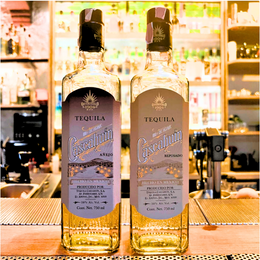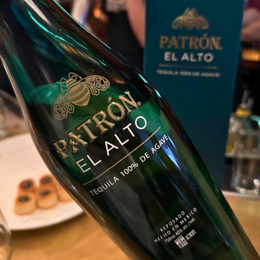Meet The 4th Generation Camarena's G4 Tequila: From The Family Who Brought You Tapatio And El Tesoro; Taste Testing G4 Tequila's Blanco, Reposado & Anejo

When it comes to Tequila, this agave spirit that has endured for hundreds of years, the reality is there's some context that we're always going to be stepping in - and in this case, there are several dynasties so to speak, and one of them is the Camarena family.
The Camarena's are well into their third generation of Tequilero's, having been at it since the 1800's, and are a formidable and far-reaching force in the world of Tequila to say the least - first generation Pedro Camarena Ramirez had crafted Tequilas through the 1910 Mexican Revolution (his own father having the honour of being the first to bring Blue Agaves to the Jalisco Highlands), and had trained his son Felipe Camarena, who in turn founded the cult followed La Altena Distillery that produces the massively acclaimed Tapatio and El Tesoro; second generation Felipe Camarena would eventually hand over La Altena to his five daughters, whilst his son, also named Felipe (who we'll be finding out more about today), would himself create the G4 brand; third generation Felipe's cousin helms the Camarena-brand Tequila, whilst his brother Carlos served (until most recently having passed the role on to his daughter Jenny) as the Master Tequilero of yet another cult classic Ocho Tequila that's also produced at La Altena. The list goes on.
So if you're going to talk Tequila, it's well worth getting versed with the work of the Camarena's.


Third generation Felipe Camarena.
“I’m not in the business of fancy bottles, I’m in the business of making tequila.”
And so today, we trace down the line to third generation Felipe Camarena and his G4 brand Tequila - "G4" symbolises the 4th Generation of the Camarena's, which in this case would take the form of Felipe's sons, Felipe and Alan. Yet as the saying goes, it's all in the name - that third generation Felipe named his Tequila brand after the next generation is instructive in giving us insight into where his mind is focused on. And it's in this regard that Felipe's work stands out from the rest.
Nicknamed "The Mad Scientist", third generation Felipe is entirely consumed by his desire to not just make high quality Tequilas - already a given considering his decades of experience and family heritage - but also one that is sustainable. In that sense, whilst Felipe's inventiveness and innovation is often touted, much of it isn't quite directed at the augmenting of the Tequila's quality or flavours, but instead is much more focused on ensuring the process can be passed on to the next generation.

The El Pandillo Distillery.
At the El Pandillo distillery, Felipe safeguards traditional Tequila-making practices such as slow-cooking well matured agaves that's harvested from Felipe's own estate, in brick ovens (as opposed to an industrial autoclave), which is then crushed by what Felipe calls the "Felipestein", a mechanical invention that reinterprets the Tahona wheel with a massive steamroller (which he's named Igor, in keeping true to the Mary Shelley classic novella Frankenstein) that's made to run on railcar axles - and yes, as you might have already guessed, this is entirely Felipe's own invention. Felipe says that the "Felipestein" allows him to continue to upkeep the traditional methods of crushing the agave whilst also making more efficient use of energy, water and manpower. The juices that's collected from the crushed agaves are then naturally fermented with a proprietary family yeast in open-air wooden vats that give way to more terroir-led, complex flavours. Double distillation then takes place in a custom-built copper pot still, from which Felipe (together with his sons) craft a range of classic Tequila's from Blanco to Reposado, Anejo and varying ages of Extra Anejo. garnished by several unique Blanco's (one that features the use of purely deep drawn wellwater, as well as another that's a high proof 108 version).

The Felipestein roller.
When asked why Felipe would go through all this effort in creating his own machinery, his attention to detail and absolutely meticulous understanding of Tequila-making becomes immediately clear, “Everyone else only has one steamer on the bottom or the top, and you will end up with unevenly cooked agave. Who wants a tequila made from uncooked agave?” says Felipe.
Yet, the obsession hardly stops there.
In his agave fields, Felipe has spent the better part of a decade (and really likely longer) trying to bring back biodiversity. It's been long warned by agave experts (critically important when much of your country's heritage export and economy depends on the crop) that the persistent and large scale commercial replanting and cloning of a narrow sample of agaves (that deliver the most commercially optimised features) leaves the agricultural crop incredibly vulnerable - one disaster is enough to wipe out most of Mexico's agaves, given that much of the agaves currently planted share the same genetics and are thus near identical in their vulnerabilities. More variety in resistance is necessary, which goes back to having greater biodiversity in the agave strains being farmed - yet, who would be willing to let go of commercial sensibilities, further exacerbated by the fact that unlike any other crop, agaves only mature after 7-8 years, making the waiting time incredibly onerous.

Trees are planted all around the estate's agave fields.
And thus Felipe has made sure to see to it that his agave fields should never suffer such a fate. He's planted cinnamon trees, guavas, figs and citruses, so as to bring birds and other natural pollinators back to his fields who can help cross breed his agaves. “I’m seeing bugs and birds around here that I haven’t seen here in years," says Felipe.
Felipe has also built a rain catchment fountain that's kept constantly running so as to stay fresh, and yet it too serves a greater purpose - whilst the distillery relies on a water well that's dug deep beneath the surface, Felipe is concerned that an overuse of the underground aquifer's waters may run it dry, and thus the collected rainwater helps diversity G4's sources of water needed for its Tequila-making. “Right now I am using a mixture of captured rainwater and spring water to distill G4, but eventually I want to have two tequilas to showcase the unique flavor profiles that each water - and its minerals - gives to tequila.” teases Felipe.

Not one to let anything slip by, Felipe doesn't just care for where his water comes from, but also what happens to the water that's spent from Tequila-making. Whilst clear Tequila's (Blanco's are after all the majority of Tequilas) fill up elegant glass bottles that then make their way to retail shelves, what's far less talked about is the vinazas that's produced in the process. Vinazas is a highly acidic rust-coloured liquid that's highly toxic and is yet often dumped back into the agave fields once the Tequila-making is complete. It's been a big target of environmentalists and yet remains difficult to police. Yet in a twist of irony, this poorly managed dumping of vinazas has often had the resulting impact of hurting the health of the distillery's soils, which in turn has damaged soil fertility and agave farming, making it only more costly and difficult to obtain the much needed agaves. To this end, Felipe has taken measures to reduce the toxicity of the vinazas from before it is produced, and once each batch of Tequila's are crafted, he takes further steps to adding calcium carbonate to de-acidify the liquid up until the point that it reverts back to what can be properly used as fertiliser.
Ultimately, so much of what consumes Felipe is making sure that this livelihood that has been passed through generations of the Camarena's can continue to outlive the generations prior, which in the case of G4 means not just continuing the traditional practices of making Tequila, but also in making sure that Tequila can even continue to be made with these cherished traditional practices.

“A lot of people ask me why I don’t patent any of my machinery or practices, but do you really think anybody out there will be as obsessive and crazy to work this hard and build everything out like I did?”
With all that said, it's easy to see why Felipe's G4 Tequila is held in such high esteem by Tequila fans as a cult producer in its own league.
With all that said, we're going to get a super rare chance to try the entire range of G4 Tequila's from Blanc to Reposado and Anejo.
PS. Big shoutout to Singapore's one and only Cat Bite Club which is not just run by some of the nicest folks, but is also veritably the one and only best place for Tequila, Mezcal, Sotol and much more! They do baller things like carrying some of the cult-est of cult expressions - definitely go check them out!
Tequila Review: G4 Tequila Blanco
This is made from 50/50 blend of spring water and collected rainwater, along with the family's proprietary agave yeast. it is bottled at 40% ABV (80 Proof).

Tasting Notes
Aroma: It opens somewhat confectionary and sweet, with time showcasing these candied fruit aromas of banana hard candy and apple candy, followed then by a mild vegetal aroma of freshly cut grass and sliced underripe peaches. Letting the tequila sit, the aromas coalesce towards a light smoke from smoked wood chips.
Taste: The confectionary tones are gentler here, yet with an accent of steamed sweet baby carrots, sweetcorn and sweet green tea. A slight smokiness is more present in the palate here as well, like hot coals and charred green capsicums. It's rich and supple, with an understated concentration to the flavours.
Finish: The finish is rather subtle, leaving behind a warming, dried ginger and ground white pepper heat. A bit of that wood chip cinder residual smoky flavours linger on, of roasted greens, charred capsicums and baked potatoes.
My Thoughts
Really classic stuff, it opens surprisingly approachable and rather confectionary even. Yet as it sits, it almost takes a more woody tone, with the smokier flavours revealing itself. It's straightforward, yet at the same time intentional and selective in how it comes across. Really approachable, but also strikes me as being very versatile. I could easily see it as part of a cocktail recipe, without it dominating, allowing for layers to be built upon it.
Tequila Review: G4 Tequila Reposado
This is aged for a minimum of 6 months in very old George Dickel Tennessee whisky barrels. It's bottled at 40% ABV (80 Proof).

Tasting Notes
Aroma: Slightly charred and caramel-forward on the initial nose, with burnt brown sugar, brown sugar syrup and toffee aromas arising at first. Letting it sit for a bit, sweeter aromas of brown sugar, vanilla and molasses arise, being less charred and smokey in character. Sliced apple, pear and carrots then take over the earth forward aromas. Leaving the tequila to sit in the glass, scented birch wood pieces become the mainstay aroma.
Taste: Relatively sweet and rounded on the palate - giving flavours of toffee apples, caramel bites and brown sugar syrup initially. The sweetness continues to linger as it sits on the palate, giving more flavours of sweet apple juice, crushed pears and vanilla ice cream. There is a slight thickness and viscosity on the palate, contributing to the impression of milky flavours of ice cream, vanilla custard and cream.
Finish: The finish is very subtle, leaving traces of smoked wood, hardened caramel chips initially. There is a slight grassiness on the palate in the finish, akin to cut grass and hay, that prickles on the sides of the tongue. The vegetal aromas and flavours grow in intensity, becoming more like fresh rocket and chard, before tapering off.
My Thoughts
Compared to the Blanco, the Reposado is even easier drinking - the flavours are really approachable, rounded and smooth, a sort of no friction kind of profile that can be appreciated by most. The American whisky barrels clearly have had an influence. This feels like a good Reposado to start with as it's not overly austere, and yet weaves in some of that precise and intense vegetal notes from time to time, backed up by all that richness. It's got a really good texture to the body, one that is incredibly seamless and unique in just how creamy it is.
Tequila Review: G4 Tequila Anejo
This one's aged for 18 months, also bottled at 40% ABV (80 Proof).

Tasting Notes
Aroma: It opens chocolately on the nose: milk chocolate, malt chocolate powder drinks and cacao powder. Then, more caramel, cooked sugar confectionery flavours arise, with caramel sauce, toffee, dark brown sugar aromas arising. There is a backbone of vanillin throughout the nosing - vanilla custard cream and vanilla icing supports the overall sweet and dessert-forward aromas. After letting the tequila sit on the glass a bit more, sliced apples and juicy pears are picked up.
Taste: Subtly sweet and chocolately - semi-sweet chocolate chips, cacao-heavy brownies and chocolate sprinkles come to mind. After the initially sweeter chocolate flavours, more on sarsaparilla syrup and light brown sugar arise, before giving way to sliced soft apples and ripened pears. After sitting, the flavours coalesce towards spiced baked pear.
Finish: On the finish, it remains fairly confectionary, with baking spices, cinnamon muffins and cinnamon toast crunch cereal. Occasionally, a dried flower flavour pops in and out, like dried osmanthus and chrysanthemum, alongside the aromas and warmth of dried ginger.
My Thoughts
This Anejo is the most balanced and yet also most concentrated of them all, with an intensity of the earthy chocolate flavours. It offers complexity not so much in the way of a big spectrum of flavours, but in its exploring of different accents from the the same core flavours. Into the finish, it's got a big spiced quality, with more of a dried floral note that's alittle more wild and delightful. If I had to choose a sipping Tequila out of the three, this would be my pick!

@vernoncelli






